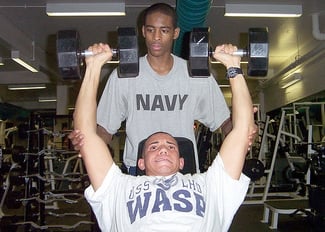Workout Injury Statistics
Over the last ten years, injuries from weight lifting have steadily risen. The American Journal of Sports Medicine recently conducted a study based on the national injury surveillance database to determine the amount, cause, and types of injuries most associated with weightlifting. Below are some of the most significant statistics from their study:
- During the ten-year period the study was conducted, over one million people in the United States were treated in emergency rooms with weightlifting injuries.
- Injuries increased 48% during the research period.
- Men sustained 82% of the injuries reviewed during this period.
- The most common injury occurred when a weightlifter dropped weights on themselves, got caught between weights, or hit themselves with weights.
- A study by Medicine and Science in Sports and Exercise concluded that using spotters during weightlifting can dramatically decrease injury frequency.
Why Use a Spotter During Weight Lifting?
Using a spotter is always a good practice for weightlifting, but it is essential when attempting heavy or advanced lifts. Spotters not only help protect weight lifters from injuring themselves, they can also increase the effectiveness of the workout. The following tips are some of the reasons why spotters are an essential part of any weightlifting activity.
Ensure Proper Technique
 The effectiveness and safety of weightlifting is dependent primarily on technique. Incorrect technique can be harmful to weightlifters and result in serious injuries. Spotters can be useful in this regard since they can observe the weightlifting and ensure lifts are being done properly.
The effectiveness and safety of weightlifting is dependent primarily on technique. Incorrect technique can be harmful to weightlifters and result in serious injuries. Spotters can be useful in this regard since they can observe the weightlifting and ensure lifts are being done properly.
Protection From Dropping
One of the most common causes of injuries from weightlifting is from dropping the weights. Individuals attempting to lift more weight than they are able to will drop the weights out of exhaustion or desperation. These dropped weights can fall on the weightlifter and lead to severe injury. Spotters can prevent weights from dropping by guiding the weights safely back to the rack or assisting the lifter in lowering them to the ground in a safe and controlled manner.
Protection From Straining
Another way spotters can assist weightlifters is by preventing injuries from strain. Sole weightlifters attempting to lift more weight than they are able will often experience strain injuries struggling to relieve themselves from too much weight. If a weightlifter is struggling, the spotter can assist them and keep them from having to strain and possibly injure themselves.
Protect Weight Lifting Equipment
Weightlifting without a spotter can also lead to damage to equipment within your facility. Weight dropping or re-racking weights too hard can damage weights and equipment so using a spotter is a great way to protect weights and equipment from excessive wear and damage.
Protection for Other Weight Lifters
Not using a spotter while weightlifting can also result in injuries to other members. If a weightlifter becomes distressed while lifting and is not using a spotter they naturally try to free themselves from the weight and drop it. Depending on the proximity of other members, the falling weight could cause a serious injury.
Safe Spotting Techniques
Simply having a spotter is not necessarily enough to ensure weightlifting activities are done safely; the spotter also needs to be familiar with their role and be able to assist enough with the weights being lifted. The following are some tips to ensure that anyone spotting a weightlifter does so as safely as possible.
Communication
It is important for weightlifters and spotters to be able to communicate with one another. If someone is struggling to complete a lift, they need to be able to convey that to their spotter so they know to intervene and assist them. It is also a good practice, before starting an exercise, to know the goal of the weightlifter so you can better assist them while spotting.
While in the middle of a lift, however, the weightlifter may be unable to communicate effectively with their spotter. A good rule of thumb for all spotters to follow is that if it appears the weightlifter needs assistance they probably do. When in doubt a spotter should intervene immediately. It is much better to interrupt a lift than to allow serious injury.
Understanding of Technique
Good spotters should also have an understanding of weightlifting and weightlifting techniques. How can you spot someone effectively if you don’t know if they are doing something incorrectly? One of a spotters main goals is to ensure the individual is doing their exercise correctly in order to both gain the maximum effect of the workout and to avoid any injuries.
Understanding of Equipment
Spotters should also be familiar with the weightlifting equipment being used. This is important to ensure that the weightlifter uses it correctly and that it is in proper working order. It is a good practice to inspect any exercise equipment before using it. Some equipment will require a spotter to get into a different position to be effective.
Adequate Strength
The main goal of a spotter is to keep the weightlifter safe and prevent them from injuring themselves or others. Being able to adequately assist while spotting is essential to being a good spotter. A spotter doesn’t need to be able to lift the entire amount being lifted, but they do need to posses enough strength to assist the weightlifter in re-racking or removing the weight from them.




